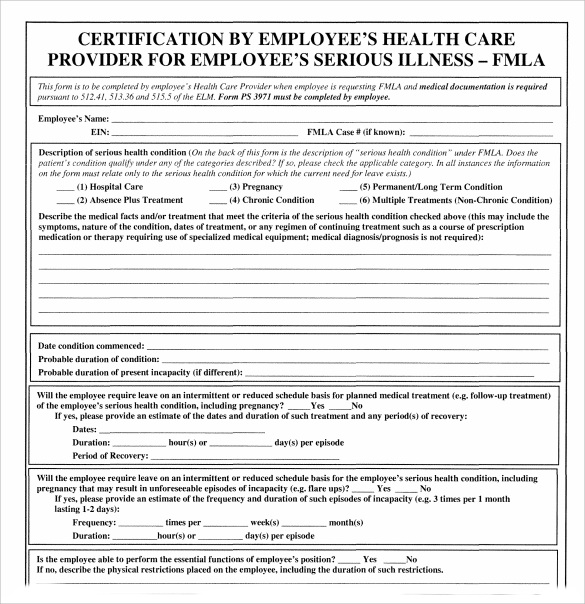Which Doctor Can Complete Your FMLA Paperwork?

When it comes to managing medical leaves, navigating the Family and Medical Leave Act (FMLA) can be a daunting task. The FMLA provides eligible employees with the right to unpaid, job-protected leave for certain family and medical reasons. A critical part of this process involves filling out FMLA paperwork, which requires medical certification from a healthcare provider. But who qualifies as a healthcare provider under FMLA? Understanding this can save time and ensure a smoother process.
Who Qualifies as a Healthcare Provider?

The U.S. Department of Labor outlines specific criteria for healthcare providers eligible to certify FMLA paperwork:
- Doctors of Medicine (MDs) or Osteopathy (DOs): These are the most common healthcare providers involved in FMLA certification.
- Podiatrists, Dentists, Clinical Psychologists: They can certify FMLA for conditions related to their area of expertise.
- Nurse Practitioners (NPs): In many states, NPs have the authority to diagnose, treat, and prescribe medications, allowing them to certify FMLA.
- Nurse Midwives: For childbirth or related health issues, they can provide certification.
- Physician Assistants (PAs): Under the supervision of a physician or if state law permits, PAs can certify FMLA.
- Clinical Social Workers: For mental health conditions, they might be consulted.
- Chiropractors: Although their scope is limited to manual therapies, for FMLA purposes, they can certify leave if within their scope of practice.
🏥 Note: Ensure that the healthcare provider you choose has the necessary authority and certification to verify your medical condition for FMLA purposes.
What Documentation is Needed?

When seeking FMLA certification:
- Medical Certification Form: The healthcare provider completes this form, detailing the health condition, treatment plan, and expected duration of the leave.
- Employer’s FMLA Policy: A copy of this policy might be required for the healthcare provider to fill out the certification correctly.
- Proof of Consultation or Treatment: Any records or notes from recent consultations or treatments might help in substantiating the need for leave.
- Contact Information: Ensure your healthcare provider has a clear understanding of how to contact HR or the FMLA administrator at your workplace.
How to Communicate with Healthcare Providers

Here are steps to streamline the process with your healthcare provider:
- Explain the Situation: Provide a brief overview of why you’re applying for FMLA leave and what your health needs are.
- Submit Forms: Send or give your healthcare provider the necessary FMLA forms, explaining any deadlines or timelines set by your employer.
- Follow Up: Make sure to check in with them, ensuring they have all the information and understand the urgency of completing the forms.
- Provide Support: Offer to provide additional medical records or make follow-up appointments to discuss the condition further if necessary.
Common Challenges with FMLA Certification

Navigating FMLA certification can present several challenges:
- Incomplete Forms: Sometimes, healthcare providers might not fill out all sections or might miss crucial information, leading to delays.
- Lack of Communication: Employers might not clearly communicate their requirements to healthcare providers.
- Privacy Concerns: Employees might be wary of revealing medical details to their employers, which can complicate the process.
- Insufficient Information: Healthcare providers might need more background information from employees to complete the forms accurately.
🔍 Note: To avoid delays, ensure that all sections of the certification form are completed, and keep open lines of communication with both your employer and your healthcare provider.
What Happens After Certification?

Once your healthcare provider certifies your FMLA paperwork:
- Submission: Return the completed form to your employer within the specified timeframe.
- Review: Your employer will review the certification to determine eligibility and plan for your leave.
- Approval: If approved, details about your leave duration, intermittent leave if applicable, and return-to-work plan will be discussed.
- Documentation: Keep copies of all FMLA-related documents for your records.
In summary, knowing who can certify your FMLA paperwork is crucial to a smooth leave process. By understanding the qualifications of different healthcare providers and following the necessary steps, employees can ensure their health needs are met while protecting their employment. This process not only helps in maintaining personal well-being but also in safeguarding professional rights and job security during times of medical necessity.
Can I use a chiropractor for FMLA certification if my issue isn’t related to the spine?

+
While chiropractors are qualified to certify FMLA for conditions within their scope of practice, they might not be the appropriate provider for unrelated health issues.
What happens if my employer disagrees with the certification provided by my healthcare provider?

+
Your employer might request a second opinion from another provider they select at their expense. If there’s still a disagreement, a third opinion can be arranged.
How long does my employer have to approve or deny my FMLA request?

+
According to FMLA regulations, employers have 5 business days to provide a response after receiving a complete and sufficient certification.
Can I take intermittent FMLA leave?

+
Yes, if medically necessary, FMLA allows for intermittent or reduced leave schedules, which must be supported by your healthcare provider’s certification.



